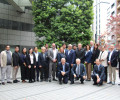Getting to grips with tyres

Q: What prompted Pirelli to become an FIA Mobility Conference partner?
Paul Hembery: Mobility is our business. So the opportunity to partner with the FIA, who we have worked with for many years on a variety of initiatives, comes quite naturally. It’s a fantastic event and to be able to see and feel what’s going on around the world of the FIA Mobility clubs is a valuable source of information for a company like Pirelli.
Q: Where can the partnership take Pirelli in the future?
PH: I think it’s quite unique to be able to get such a global representation of the automotive world together. I think that for a lot of businesses, not just our own, there is a great opportunity here to connect up in that manner. From our point of view, I think it’s certainly an opportunity to understand what their needs are as automotive clubs and see where there might be some common areas of interest.
Q: One of Pirelli’s key areas of focus is research and development. What can we expect to see in the near future?
PH: We’re currently working on connecting up the vehicle and the tyre. It’s almost the holy grail for vehicle
manufacturers to be able to talk with the tyre because it is the contact with the road; it is the one piece of equipment that will stop you going off in a corner. If a car manufacturer can read the road conditions then it could make a big difference to what they do in terms of vehicle dynamics. That’s probably going to take a few
years yet but we’re already working with what we call a Cyber Truck Tyre, which is a way for truck fleets to understand what’s happening with their products. Bear in mind, if you don’t have the right inflation pressures
in your tyres, fuel consumption can increase and in the worst situation it could lead to potential failure.
Q: Can that technology be linked to road safety?
PH: Absolutely. The second largest creator of road incidents is tyre related incidents and in the majority of cases that’s through people not controlling the condition of the product. If you’re able to give information back easily to the user, be it directly in the vehicle or to fleet managers, then you can reduce the incidence of that problem with road safety.
Q: Finally, give us your top two tips for looking after the tyres on your car?
PH: Firstly, look at them! Most people don’t know what tyres have on their car. Secondly, you must control the pressures and the operating conditions. Get the geometry checked out, check your pressures. Two pounds per square inch on your car is probably worth around 300 euros per year. That’s a free set of tyres. That’s a pretty good argument for doing it!

 Facebook
Facebook Twitter
Twitter






